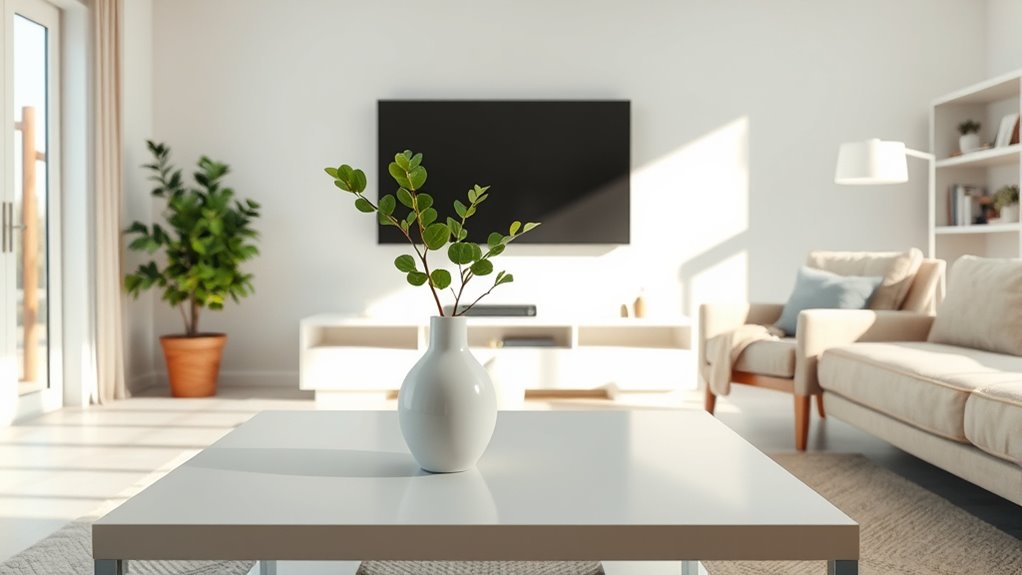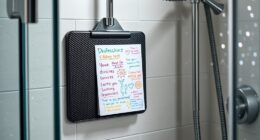Digital minimalism helps clear your mind by reducing digital clutter and limiting unnecessary screen time, which decreases mental overload and stress. It encourages setting boundaries, like phone-free zones and specific disconnect hours, so you can focus on what truly matters. At home, decluttering apps and devices creates a calmer, more organized space. By simplifying your digital life, you make room for meaningful experiences and relaxation—discover how to achieve this balance, starting now.
Key Takeaways
- Reducing digital clutter minimizes mental overload and physical chaos, creating a calmer and more organized environment.
- Setting boundaries and limiting screen time fosters focus, mindfulness, and emotional well-being.
- Eliminating unnecessary apps and notifications decreases distractions, freeing mental space for meaningful activities.
- Digital detoxes promote clarity by reducing overstimulation and encouraging presence in the moment.
- Simplifying digital habits supports a balanced lifestyle, improving overall mental health and home harmony.

Have you ever felt overwhelmed by the constant barrage of notifications, apps, and digital distractions? It’s a familiar feeling in today’s hyper-connected world. You check your phone first thing in the morning, scroll through social media during breaks, and find yourself mindlessly tapping away at your screen late into the night. This relentless stream of information can drain your mental energy and clutter your living space, making it harder to focus on what truly matters. That’s where a tech detox and reducing your screen time can make a significant difference. Cutting back on digital distractions isn’t just about freeing up time; it’s about reclaiming your mental clarity and creating a calmer environment at home.
Overwhelmed by constant notifications? A tech detox can restore your mental clarity and create a calmer home environment.
When you intentionally limit your screen time, you give your mind a much-needed break from constant digital stimulation. Instead of reacting to every notification, you start to focus on meaningful activities—reading, walking, or simply being present. A tech detox involves setting boundaries with your devices, like designating phone-free zones or specific hours where you disconnect entirely. These small steps help you disconnect from the digital noise and reconnect with yourself. As you reduce your screen time, you’ll notice your thoughts becoming clearer, your stress levels decreasing, and your attention span improving. Your mental space clears, allowing you to prioritize what truly matters without the distraction of endless notifications. Incorporating necessary cookies into your digital habits reminds you to focus on essentials and avoid unnecessary digital overload.
This process not only benefits your mind but also transforms your home environment. Digital clutter often spills over into physical space—piles of devices, charging cords, screens left on in every room. Simplifying your digital life naturally leads to a tidier home. When you cut down on unnecessary apps and notifications, your living space feels less chaotic. You might find yourself decluttering your devices, deleting unused apps, or organizing cords and gadgets. This physical decluttering creates a sense of calm and order, making your home a more peaceful place to relax and recharge. Less digital clutter means fewer distractions, allowing you to enjoy your space without constant interruptions.
Embracing digital minimalism ultimately frees up both your mind and your home. It’s about making intentional choices—deciding what digital tools serve you and eliminating what doesn’t. By lowering your screen time and taking regular tech detoxes, you create space for more meaningful experiences and genuine connections. Your mind becomes less overwhelmed, your home more organized, and your overall well-being improves. It’s a simple shift in how you approach technology, but one that can profoundly impact your peace of mind and the harmony of your living space.
Frequently Asked Questions
How Can I Start Practicing Digital Minimalism Effectively?
To start practicing digital minimalism effectively, set clear digital boundaries by limiting your screen time and disabling non-essential notifications. Focus on intentional technology use by choosing apps and online activities that truly add value to your life. Begin small, like designating tech-free zones or times, and gradually build habits that prioritize quality over quantity. This approach helps you regain control, reduce distractions, and create a more mindful connection with your digital environment.
What Are Common Challenges When Decluttering Digital Space?
When decluttering your digital space, you’ll face common challenges like digital overload and notification fatigue. You might feel tempted to keep everything out of habit or overwhelmed by constant alerts. It’s easy to get stuck trying to organize every file or app, but staying focused helps. Set boundaries, turn off unnecessary notifications, and prioritize what truly matters. This approach makes it easier to regain control and enjoy a calmer digital environment.
How Does Digital Minimalism Impact Mental Health Long-Term?
Sure, digital overload might seem like a minor annoyance, but it secretly sabotages your emotional well-being in the long run. By embracing digital minimalism, you cut through the noise, giving your mind room to breathe. This reduces stress and boosts mental clarity, helping you stay emotionally balanced. Over time, you’ll notice improved mood, better focus, and a healthier relationship with your devices—ultimately, a happier, more grounded you.
Can Digital Minimalism Improve Productivity at Work or Study?
Digital minimalism can boost your productivity at work or study by reducing digital distraction. When you limit notifications and unnecessary apps, you stay focused longer. This focus enhancement helps you complete tasks more efficiently and with better quality. By creating a calmer digital environment, you minimize interruptions, making it easier to concentrate. Ultimately, embracing digital minimalism allows you to use your time more intentionally, leading to improved performance and less stress.
What Tools or Apps Support Digital Minimalism Efforts?
Think of your apps as garden tools—use the right ones to keep your space tidy. Apps like Forest or Freedom help you set app restrictions, blocking distractions during focus time. Notification management apps like Screen Time or StayFocusd let you control alerts, so you’re not pulled away constantly. These tools support your digital minimalism efforts, making it easier to focus, declutter, and reclaim your mental clarity and home environment.
Conclusion
By embracing digital minimalism, you’ll free your focus, foster peace, and find more fulfillment. Cutting clutter clears your calendar and calms your mind, creating space for what truly matters. When you simplify your screens and streamline your habits, you’ll discover a deeper sense of balance and brilliance. So, step away from the chaos, simplify your space, and savor the serenity that comes with a more mindful, minimal digital life. Your mind and home will thank you.









